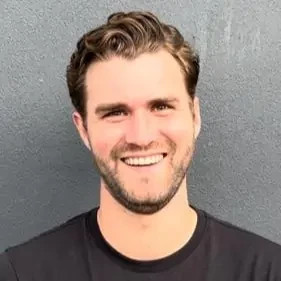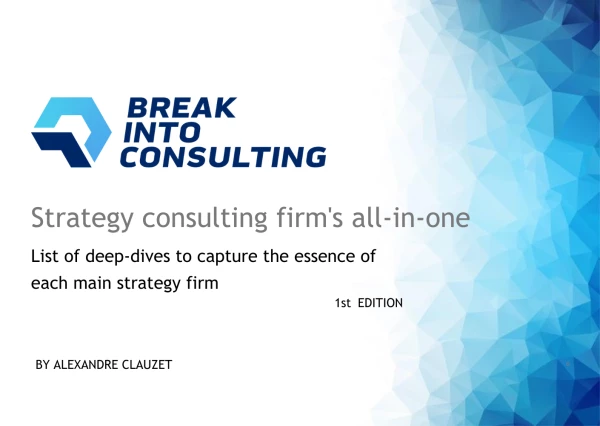How to think more strategically and broadly when doing cases? Would you recommend any books, or does it just come with time and practice? My problem is that I tend to look very superficially. For example, during one of the cases, I had this question: What are the main factors driving revenue from memberships at a local gym? Key ideas given: • Contract length • Customer retention • Gym's visibility But ideas that came to my mind were: • Seasonality • Price • Competition in the area • Gym's technical condition • Gym’s occupancy As you can see, my ideas are less creative and not as general. Unfortunately, I don't know how to start thinking differently.
How can I think more strategically and broadly during case studies? Do you recommend any books, or does this skill come with time and practice? My current approach seems too superficial.


I have good news for you, you don’t really need to learn frameworks. Some are useful, but chances are you will get very strange cases you cannot solve with a learned framework.
And, however often you hear that you need to think in a certain way… it’s not true.
Step 1: Dump All Topics you can think of in the Middle of the Paper
- Seasonality
- Price
- Competition
- Gym’s Condition
- Occupancy
- Contract Length
- Customer Retention
- Gym’s Visibility
- Marketing
- Location
- Services Offered
- Customer Demographics
Step 2: Group into Themes. Write categories on the left-hand side of the paper.
- Customers: Customer Retention, Customer Demographics
- Pricing: Price, Contract Length
- Competition: Other local gyms, alternative fitness options
- Operations: Gym’s Condition, Occupancy, Staff
- Services Offered: [BLANK]
- Branding: Gym’s Visibility, Location, Marketing
- [BLANK]: Seasonality
Note: do not worry if there are blanks at this stage for topics you cannot assign
Step 3: Check for Breadth by always double checking for the following:
- Stakeholders:
- Demand Side: Current members, potential members, lapsed members
- Supply Side: Gym owners, staff/trainers, suppliers, investors
- Environmental Factors:
- Economic conditions (e.g., recession)
- Health trends (e.g., yoga is trendy now)
- Technological advancements (e.g., fitness apps)
- Local regulations
Step 4: Check for MECEness. Enhance the existing list with any relevant items you discovered in Step 3:
- Include staff and suppliers into operations
- Expand list with Investors and Gym owners
- Expand the list with Environmental factors
- Include seasonality into environmental factors
Your updated list now looks like this:
- Customers: Customer Retention, Customer Demographics
- Pricing: Price, Contract Length
- Competition: Other local gyms, alternative fitness options
- Operations: Gym’s Condition, Occupancy, Staff
- Services Offered: [BLANK]
- Branding: Gym’s Visibility, Location, Marketing
- Environment: Economic conditions, health trends, tech, regulations, seasonality
- Investors: [BLANK]
Step 5: Check for Depth. For each theme, you can add detail by using what, when, where, how questions (as applicable):
- Customers: demographics, peak times for sign-ups/cancellations, member locations, reasons for joining/leaving
- Services Offered: types of sports, delivery methods (e.g., online, group classes, individual sessions), membership benefits (nutrition guidelines, protein bar, therapist,…)
- Pricing: pricing tiers, promotions available, price sensitivity, value perception
- Competition: location of competitor gyms, customers, services, pricing,…
- Operations: equipment condition, staff qualifications, maintenance schedule, opening hours, layout
- Branding: brand image and fit to customer demographic, marketing channels, campaign timings, referral programs
- Environment: economic conditions, health trends, sports trends, technological advancements, regulations, seasonality
- Investors: expectations, requirements, concerns
Step 6: Refine the topics with Hypotheses. For each topic, ask "Why would this topic affect the problem at hand?", i.e., “why would this topic affect revenues?”
- Customers: targeting wrong demographics, opening at wrong times, operating in the wrong location, not offering desired services (see next)
- Services Offered: offering unpopular sports or setups (e.g., not in groups, no individual coaching, no nutritionist services)
- Pricing: too expensive for what is currently offered
- Competition: nearby competitors with better perceived offerings for the target demographic
- Operations: poor equipment condition, unqualified / unfriendly staff, conflicting maintenance schedule, inefficient layout
- Branding: using wrong channels to advertise to target audience
- Environment: economic downturn, new health trends not serviced, lack of technological integration, not leveraging seasonality for promotions
- Investors: focused on cost-cutting affecting quality of operations
Step 7: Think About Data. Identify the types of data needed to test your hypotheses:
- Customers: demographic data, satisfaction surveys, retention rates
- Services Offered: list of services, usage statistics
- Pricing: pricing tiers, volume of sales by tier, promotional impact
- Competition: list of competitors, their services, and pricing
- Operations: equipment renewal records, maintenance schedules, staff qualifications, number of staff (FTEs)
- Branding: marketing channels and campaign performance data
- Environment: economic indicators, health and sports trend reports
- Investors: investor expectations, reports on cost-cutting measures and their impact
Step 8. Order how you will present your thoughts.
- State out loud that you have thought of several categories, for each you have hypothesis on how they could contribute to a revenue decline, and that you have some ideas on how you could confirm each.
- Then present the categories.
- Then lay out your hypothesis from most plausible to least plausible.
- Then say the data you would look for to confirm them.
- Finally, ask the interviewer if these make sense
Starting from a page that is not blank is a lot easier than trying to be structured in your mind from the beginning.
Train finding categories and asking questions to initial ideas and you will naturally get better at both structuring and being creative.
The examples I am giving above are not even that creative and they would be enough to come across as thoughtful and as someone who has full ownership of their work and is capable of driving the case autonomously.

To address your concern, let me first commend you for recognizing this area for improvement. Self-awareness is the first step towards growth, and your willingness to identify and work on this aspect will serve you well in your consulting journey.
Strategies to Cultivate a Strategic and Broad-Thinking Mindset
- Practice with a Structured Approach:
- Break Down Case Questions: Develop a habit of breaking down case questions into their fundamental components. Consider the following:
- Who are the key stakeholders involved?
- What are the underlying drivers or factors influencing the situation?
- What are the potential implications or ripple effects?
- This structured approach can help you identify a more comprehensive set of considerations beyond the obvious ones.
- Break Down Case Questions: Develop a habit of breaking down case questions into their fundamental components. Consider the following:
- Read Broadly and Stay Curious:
- Expand Your Knowledge: Read widely across various industries, business topics, and current events to broaden your perspective.
- Cultivate Curiosity: Constantly seek to understand the "why" behind phenomena. This curiosity will help you make connections between seemingly unrelated concepts.
- Leverage Frameworks and Mental Models:
- Familiarize Yourself with Business Frameworks: Learn and use widely-recognized business frameworks and mental models, such as Porter's Five Forces, SWOT analysis, or the Business Model Canvas.
- Analyze Situations from Multiple Angles: These tools provide a structured way to analyze situations, prompting you to consider a broader range of factors.
- Practice Case Studies:
- Engage with Case Study Materials: Use materials from reputable sources, such as consulting firms or business schools.
- Challenge Yourself: Think beyond the obvious and consider alternative perspectives as you work through these cases.
- Seek Diverse Perspectives:
- Collaborate with Others: Engage in discussions with people from different backgrounds, experiences, and thought processes.
- Broaden Your Understanding: Exchanging viewpoints can expose you to new ways of thinking about problems.
Recommended Resources
- Books:
- "The McKinsey Way" by Ethan M. Rasiel
- "Case in Point" by Marc P. Cosentino
- "The Pyramid Principle" by Barbara Minto
- "Cracked It!" by Bernard Garrette, Corey Phelps, and Olivier Sibony

You can start reading about key drivers and challanges of different industries. But truly, this will come from practice, reading in general about different businesses from business magazines, and then connecting the dots when you encounter the cases. It will never be perfect and there is no one strategy- you just have to be curious about businesses in general so you have some basic knowledge but at the end it is common sense and building the muscles to brainstorm and be creative to solve any kind of case that comes to you.

For the case you had, you didn't need more “strategic thinking” or creativity. You needed more structure.
To be more specific, you need to consider how you would estimate the revenue of a Gym, and then consider which could be the drivers or options regarding each of the components of the revenue estimation.
Of course, just doing this is not enough - you'll need a bit of additional content or experience you can use to come up with ideas fast. You get that “experience” by doing a lot of cases, and trying to take the learnings from one all similar types of questions.

You're going to see the biggest improvement once you start getting tailored feedback from somebody with experience.
You can either get that through a coach or if you have a friend who is a senior consultant and who has experience as an interviewer.
These sort of people can then understand what you're doing wrong and when and then provide you with specific feedback on how to improve on those dimensions.
Best,
Cristian













